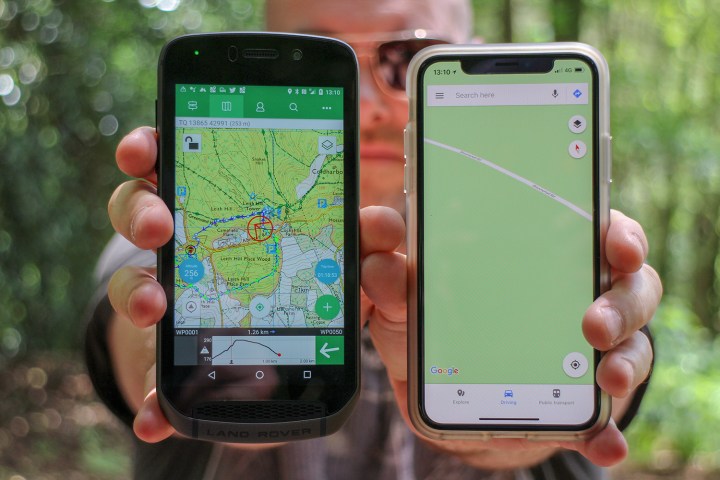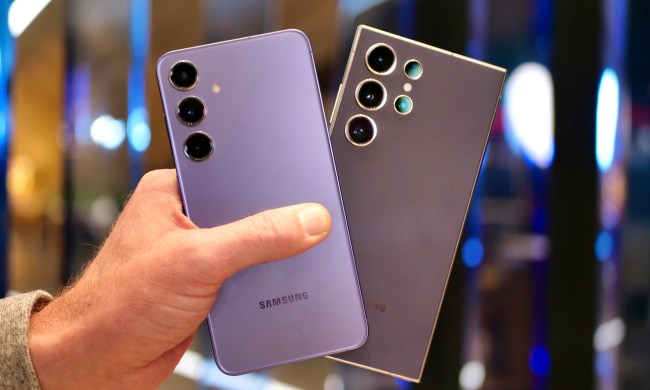Google Maps showed nothing but green surrounding me, and one nameless road some distance away. We’d taken a wrong turn winding our way up Leith Hill in Surrey, U.K., and while lost would be a strong word to use, Google Maps didn’t provide the detail and information needed to get back on the right path. Is this the beginning of a tale of survival? Eating berries, drinking dubious liquids, and sleeping under nettles with varying multi-legged creatures?
Sorry to disappoint, but no. In our hand was the Land Rover Explore, a phone designed for those who regularly get off the beaten track, wander about on hillsides, don’t see another person for 48-hours, and enjoy every minute of it. Owning it is like choosing a Land Rover vehicle. It’s not going to let you down when the going gets muddy. We wanted to try one out, however due to its very specific skill set, we decided to test its strengths on a day out, hence our excursion.
Finding your way back
The moment it became clear we took a wrong turn, Google Maps was no use. The Land Rover Explore comes with the ViewRanger app pre-installed, where we had downloaded Ordnance Survey maps of the area, and plotted a walking route. An arrow in the bottom right of the screen permanently points in the direction of travel, and a crosshair on the map indicates your exact position. We know it’s exact, because on the back of the Explore was the Adventure Pack, an extended battery with a large 25x25mm Ceramic Patch GPS antenna, so you don’t need phone reception.
- 2. Land Rover Explore
The combination of the Explore’s GPS antenna and the ViewRanger app is formidable, and the difference between navigating with it and Google Maps in remote or not easily mapped areas is considerable. We did a three mile circuit, completely unmapped by Google, and easily found our way around.
The combination of the Explore’s GPS antenna and the ViewRanger app is formidable.
The idea of taking the Explore up a mountain, or right out into the wilderness, is comforting. We were lucky to have cell reception, that it was in the daylight, and it was possible to retrace our steps. If reception was non-existent, it was dark, and we were trudging through unmarked territory, we’d have been pretty stuck without the Land Rover Explore. It felt like a trusty companion, adept at finding its way around when you’re at a loss.
Having spent three hours, with various stops for photos and video, with GPS running constantly and flicking between the camera and other Explore apps; you’d expect the battery to have taken a hit, right? We also used it with Google Maps to navigate to the starting point in the car, and again on a return journey to another destination. The internal 4,000mAh battery stayed fully charged thanks to the 3,620mAh Adventure Pack, and even the day after it still had enough juice to keep it topped up. We’d say three or four full days use would be possible using the Adventure Pack and internal battery only.
It’s a phone, too
What else makes the Explore a good outdoor companion? We like the Explore Hub, which collects special widgets useful for different outdoor pursuits — ranging from an altimeter and a compass, to weather reports and a button to quickly share your location — which is easily found with a floating quick access button. We weren’t out at night, but there is a cool night mode that gives the screen a vision-boosting red tint that won’t shine like a beacon and blind you. It’s also water resistant with an IP68 rating, super tough, and even has an H-4 screen protector fitted at the factory. A massive rubber case that holds the phone and the battery pack, complete with a carabiner hook, is included in the box to keep it safe and secure, while the screen can be used with gloves too.
That’s before you consider its strengths as an all-in-one device for exciting excursions. It’s a phone for a start, displays local emergency broadcasts, has an FM radio, access to Google Play for your app needs, and won’t give up at the first sign of cold, hot, or humid weather. Would you need to carry any other device? Probably not.
It’s difficult to argue with the Land Rover Explore’s prowess as an outdoor companion. However, it’s similarly difficult to make a case for it as an everyday use phone. With the Adventure Pack attached — the Explore uses an effective magnetic modular system, similar to Motorola’s Moto Mods, which we liked — it’s a massive brick of a thing. Take it off and it’s more manageable, but the screen is only 5-inches and has a basic HD resolution.
It’s difficult to make a case for the Land Rover Explore as an everyday use phone.
It’a a MediaTek deca-core processor inside, and it’s not the smoothest experience. Scrolling through the web or Twitter wasn’t that fast or slick. Our review phone came with Android 7.1.1 installed, so it’s sadly out of date for a brand new device, but the May 2018 security update was a welcome sight. Happily, there is little visual or theme modification to Android, and it’s simple to operate.

You’ll forgive these things when the Explore is making sure you don’t end up on a missing person report, but considerably less so if you’re planning to watch some Netflix, or manage a day’s work. The 16-megapixel camera on the back is decent, and won’t disappoint on a sunny day. At night, it’s not so great. Also, while the design of the Explore takes on elements of the Land Rover Discovery — the camera lens and grill below the screen for example — the rest is a flashback to phones released three years ago, and not the best looking ones either. The bezels, for example, are gigantic.
Hefty price tag
Then we come to the price. The Land Rover Explore is sold with the Adventure Pack for 600 British pounds, or near $800 (a U.S. release date hasn’t been confirmed yet). That’s a lot of money for a phone we don’t see anyone wanting to use everyday, and the same amount most will pay for their primary phone. Yes, there’s plenty of tech and engineering in the Land Rover Explore, plus that no doubt pricey brand name, but you’re regularly going to have to give Bear Grylls a run for his money to justify purchasing it.
We consider the Explore a phone for those wild weekends away.
If you’re serious about outdoor pursuits and want a phone that does “tough” right, the Land Rover Explore is an excellent choice. From the textured buttons on the side that are easy to locate and press, to the genuinely useful and well-thought out features, it’ll fit right in with your lifestyle and your Discovery, if you’ve bought one of those too. However, we consider the Explore a phone for those wild weekends away, and imagine it being relegated to the sidelines once you’re back to civilization.
It did everything we asked on our short hike, easily surpassing the usefulness of a regular smartphone in this situation, and we imagine its high initial price will quickly be forgotten if it saves you from certain (or at the very least, vaguely possible) doom in the wilderness just once. We’d just quickly return to our regular smartphone to tweet about our adventures.












